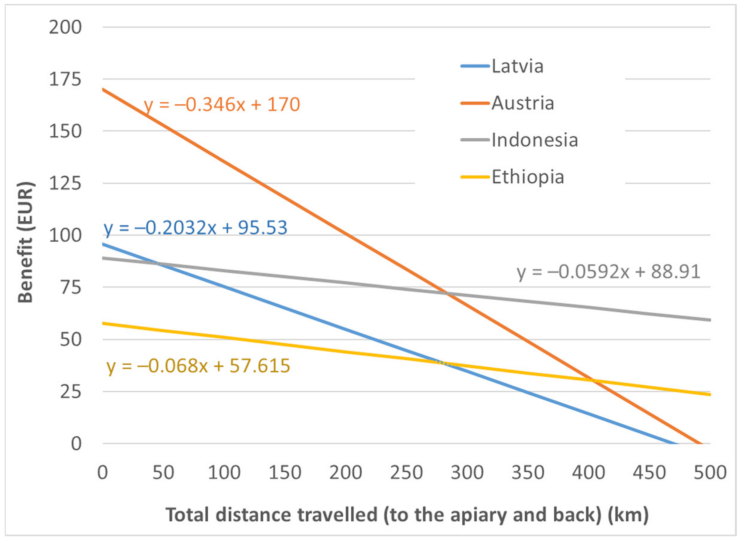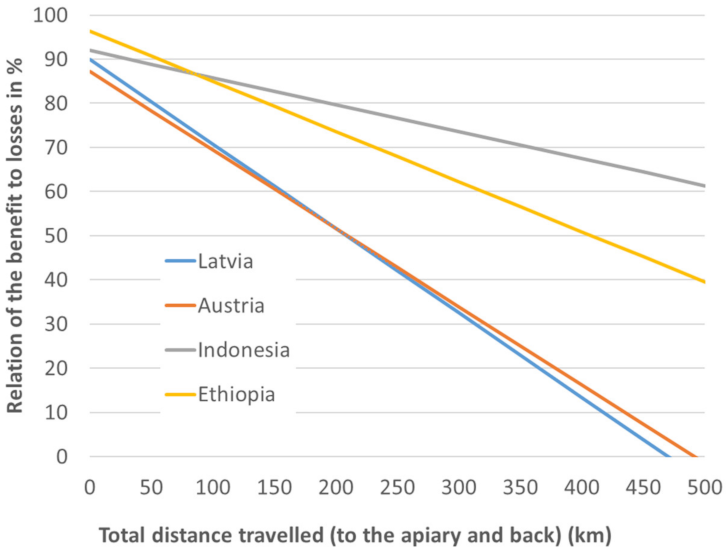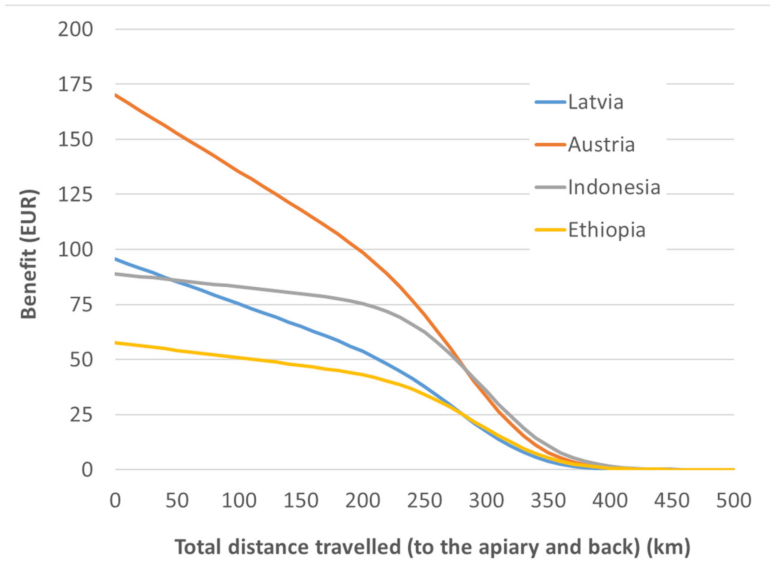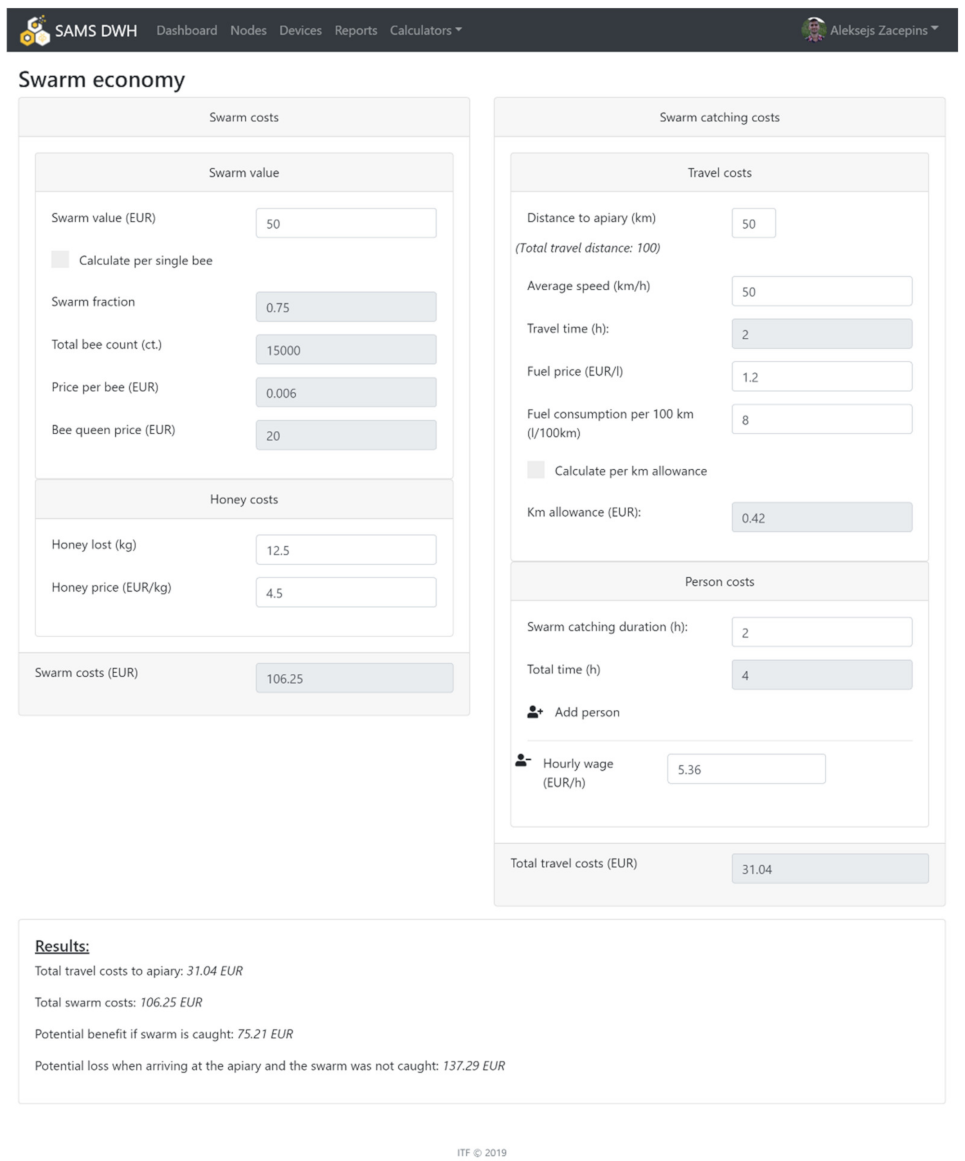When It Pays to Catch a Swarm—Evaluation of the Economic Importance of Remote Honey Bee (Apis mellifera) Colony Swarming Detection
Abstract
:1. Introduction
2. Materials and Methods
2.1. Calculation of Financial Losses Caused by Honey Bee Colony Swarming
- Pqueen = Price of the bee queen (EUR)
- Pbee = Price of one bee (EUR)
- NumOfBees = Number of bees leaving the hive (all worker bees in the colony * 0.75 (small colony up to 7000 worker bees, large colony—up to 30,000 worker bees)
- Lhoney = Potentially uncollected honey (kg) (half of the average honey production per colony per season)
- Phoney = Honey price per kg (EUR)
2.2. Calculation of Expenses to Reach the Apiary and Catch the Swarm
- Dist = Distance to the apiary (km)
- Fuelcons = Car fuel consumption for 100 km (L)
- Fuelprice = Price of one litre of fuel (EUR)
- Numpers = Number of persons involved in catching the swarm
- Perstime = Time needed to catch the swarm, including travelling time (hours). This variable can also include additional time, for example traffic, time for swarm detection, ability to start off immediately etc.
- Pershour = Salary for one person per hour (EUR)
2.3. Estimation of Parameters for Austria, Ethiopia, Indonesia and Latvia
3. Results
- Lpot = 50 + 12.5 * 4.5 = EUR 106.25
- Expfuel = 100 * 8/100 * 1.20 = EUR 9.6
- Exp = 9.6 + 21.44 = EUR 31.04
- Bnf = 106.25 − 31.04 = EUR 75.21
3.1. Economic Model including Travelled Distance
3.2. Advanced Economic Model including Swarm Catch Probability
3.3. Web Application to Ease the Evaluation of the Benefit of Catching the Swarm
4. Discussion
5. Conclusions
Author Contributions
Funding
Institutional Review Board Statement
Informed Consent Statement
Data Availability Statement
Acknowledgments
Conflicts of Interest
References
- Southwick, E.E.; Southwick, J.L. Estimating the Economic Value of Honey Bees (Hymenoptera: Apidae) as Agricultural Pollinators in the United States. J. Econ. Entomol. 1992, 85, 621–633. [Google Scholar] [CrossRef]
- Aizen, M.A.; Harder, L.D. The Global Stock of Domesticated Honey Bees Is Growing Slower Than Agricultural Demand for Pollination. Curr. Biol. 2009, 19, 915–918. [Google Scholar] [CrossRef] [PubMed] [Green Version]
- Klein, A.M.; Vaissiere, B.E.; Cane, J.H.; Steffan-Dewenter, I.; Cunningham, S.A.; Kremen, C.; Tscharntke, T. Importance of pollinators in changing landscapes for world crops. Proc. R. Soc. B Biol. Sci. 2007, 274, 303–313. [Google Scholar] [CrossRef] [Green Version]
- Gallai, N.; Salles, J.M.; Settele, J.; Vaissière, B.E. Economic valuation of the vulnerability of world agriculture confronted with pollinator decline. Ecol. Econ. 2009, 68, 810–821. [Google Scholar] [CrossRef]
- Bommarco, R.; Kleijn, D.; Potts, S.G. Ecological intensification: Harnessing ecosystem services for food security. Trends Ecol. Evol. 2013, 28, 230–238. [Google Scholar] [CrossRef] [PubMed]
- García, N.L. The Current Situation on the International Honey Market. Bee World 2018, 95, 89–94. [Google Scholar] [CrossRef]
- Potts, S.G.; Roberts, S.P.; Dean, R.; Marris, G.; Brown, M.A.; Jones, R.; Neumann, P.; Settele, J. Declines of managed honey bees and beekeepers in Europe. J. Apic. Res. 2010, 49, 15–22. [Google Scholar] [CrossRef]
- Van Engelsdorp, D.; Meixner, M.D. A historical review of managed honey bee populations in Europe and the United States and the factors that may affect them. J. Invertebr. Pathol. 2010, 103, S80–S95. [Google Scholar] [CrossRef]
- Moritz, R.F.A.; Erler, S. Lost colonies found in a data mine: Global honey trade but not pests or pesticides as a major cause of regional honeybee colony declines. Agric. Ecosyst. Environ. 2016, 216, 44–50. [Google Scholar] [CrossRef]
- Brodschneider, R.; Brus, J.; Danihlík, J. Comparison of apiculture and winter mortality of honey bee colonies (Apis mellifera) in Austria and Czechia. Agric. Ecosyst. Environ. 2019, 274, 24–32. [Google Scholar] [CrossRef]
- Gray, A.; Brodschneider, R.; Adjlane, N.; Ballis, A.; Brusbardis, V.; Charriere, J.D.; Chlebo, R.F.; Coffey, M.; Cornelissen, B.; Amaro da Costa, C.; et al. Loss rates of honey bee colonies during winter 2017/18 in 36 countries participating in the COLOSS survey, including effects of forage sources. J. Apic. Res. 2019, 58, 479–485. [Google Scholar] [CrossRef] [Green Version]
- Gray, A.; Adjlane, N.; Arab, A.; Ballis, A.; Brusbardis, V.; Charrière, J.D.; Chlebo, R.; Coffey, M.F.; Cornelissen, B.; da Amaro Costa, C.; et al. Honey bee colony winter loss rates for 35 countries participating in the COLOSS survey for winter 2018–2019, and the effects of a new queen on the risk of colony winter loss. J. Apic. Res. 2020, 59, 744–751. [Google Scholar] [CrossRef]
- Popovska Stojanov, D.; Dimitrov, L.; Danihlík, J.; Uzunov, A.; Golubovski, M.; Andonov, S.; Brodschneider, R. Direct Economic Impact Assessment of Winter Honeybee Colony Losses in Three European Countries. Agriculture 2021, 11, 398. [Google Scholar] [CrossRef]
- Zacepins, A.; Brusbardis, V.; Meitalovs, J.; Stalidzans, E. Challenges in the development of Precision Beekeeping. Biosyst. Eng. 2015, 130, 60–71. [Google Scholar] [CrossRef]
- Wakjira, K.; Negera, T.; Zacepins, A.; Kviesis, A.; Komasilovs, V.; Fiedler, S.; Kirchner, S.; Hensel, O.; Purnomo, D.; Nawawi, M.; et al. Smart apiculture management services for developing countries—the case of SAMS project in Ethiopia and Indonesia. PeerJ Comput. Sci. 2021, 7, e484. [Google Scholar] [CrossRef]
- Meikle, W.G.; Holst, N. Application of continuous monitoring of honeybee colonies. Apidologie 2015, 46, 10–22. [Google Scholar] [CrossRef] [Green Version]
- Zacepins, A.; Kviesis, A.; Stalidzans, E.; Liepniece, M.; Meitalovs, J. Remote detection of the swarming of honey bee colonies by single-point temperature monitoring. Biosyst. Eng. 2016, 148, 76–80. [Google Scholar] [CrossRef]
- Meikle, W.G.; Weiss, M.; Maes, P.W.; Fitz, W.; Snyder, L.A.; Sheehan, T.; Mott, B.M.; Anderson, K.E. Internal hive temperature as a means of monitoring honey bee colony health in a migratory beekeeping operation before and during winter. Apidologie 2017, 48, 666–680. [Google Scholar] [CrossRef] [Green Version]
- Fitzgerald, D.W.; Murphy, F.E.; Wright, W.M.; Whelan, P.M.; Popovici, E.M. Design and development of a smart weighing scale for beehive monitoring. In Proceedings of the 26th Irish Signals and Systems Conference (ISSC), Carlow, Ireland, 24–25 June 2015; pp. 1–6. [Google Scholar] [CrossRef]
- Lecocq, A.; Kryger, P.; Vejsnaes, F.; Bruun Jensen, A. Weight watching and the effect of landscape on honeybee colony productivity: Investigating the value of colony weight monitoring for the beekeeping industry. PLoS ONE 2015, 10, e0132473. [Google Scholar] [CrossRef]
- Ruan, Z.Y.; Wang, C.H.; Lin, H.J.; Huang, C.P.; Chen, Y.H.; Yang, E.C.; Tseng, C.L.; Jiang, J.A. An Internet of Things-Based Weight Monitoring System for Honey. Int. J. Agric. Biosyst. Eng. 2017, 11, 478–482. [Google Scholar]
- Ferrari, S.; Silva, M.; Guarino, M.; Berckmans, D. Monitoring of swarming sounds in bee hives for early detection of the swarming period. Comput. Electron. Agric. 2008, 64, 72–77. [Google Scholar] [CrossRef]
- Bencsik, M.; Bencsik, J.; Baxter, M.; Lucian, A.; Romieu, J.; Millet, M. Identification of the honey bee swarming process by analysing the time course of hive vibrations. Comput. Electron. Agric. 2011, 76, 44–50. [Google Scholar] [CrossRef]
- Michener, C.D. The Social Behavior of the Bees; Harvard University Press: Cambridge, UK, 1974. [Google Scholar]
- Heinrich, B.Y.B. The mechanisms and energetics of honeybee swarm temperature regulation. J. Exp. Biol. 1981, 91, 25–55. [Google Scholar] [CrossRef]
- Seeley, T.D. How Honeybees Find a Home. Sci. Am. 1982, 247, 158–168. [Google Scholar] [CrossRef]
- Winston, M.L. The Biology of the Honey Bee; Harvard University Press: Cambridge, UK, 1982. [Google Scholar] [CrossRef]
- Simpson, J. The incidence of swarming among colonies of honey-bees in England. J. Agric. Sci. 1957, 49, 387–393. [Google Scholar] [CrossRef]
- Simpson, J. The factors which cause colonies of Apis mellifera to swarm. Insectes Sociaux 1958, 5, 77–95. [Google Scholar] [CrossRef]
- Kridi, D.S.; de Carvalho, C.G.N.; Gomes, D.G. A predictive algorithm for mitigate swarming bees through proactive monitoring via wireless sensor networks. In Proceedings of the 11th ACM Symposium on Performance Evaluation of Wireless Ad Hoc, Sensor, & Ubiquitous Networks, Montreal, QC, Canada, 21–26 September 2014; pp. 41–47. [Google Scholar]
- Kviesis, A.; Zacepins, A. Application of neural networks for honey bee colony state identification. In Proceedings of the 17th International Carpathian Control Conference (ICCC), High Tatras, Slovakia, 29 May–1 June 2016; pp. 413–417. [Google Scholar]
- Buchmann, S.; Thoenes, S. The electronic scale honey bee colony as a management and research tool. Bee Sci. 1990, 1, 40–47. Available online: http://www.cabdirect.org/abstracts/19910229804.html (accessed on 4 December 2014).
- Meikle, W.; Hoist, N.; Mercadier, G. Using balances linked to dataloggers to monitor honey bee colonies. J. Apic. Res. 2006, 45, 39–41. Available online: http://cat.inist.fr/?aModele=afficheN&cpsidt=17873767 (accessed on 4 December 2014). [CrossRef]
- Rickli, M.; Bühlmann, G.; Gerig, L.; Herren, H.; Schürch, H.J.; Zeier, W.; Imdorf, A. Zur Anwendung eines elektronischen Bienenzählgerätes am Flugloch eines Bienenvolkes. Apidologie 1989, 20, 305–315. [Google Scholar] [CrossRef] [Green Version]
- Campbell, J.; Mummert, L.; Sukthankar, R. Video monitoring of honey bee colonies at the hive entrance. Vis. Obs. Anal. Anim. Insect Behav. 2008, 8, 1–4. [Google Scholar]
- Villa, J.D. Swarming behavior of honey bees (Hymenoptera: Apidae) in southeastern Louisiana. Ann. Entomol. Soc. Am. 2004, 97, 111–116. [Google Scholar] [CrossRef] [Green Version]
- Seeley, T.D. Honeybee Democracy; Princeton University Press: Princeton, NJ, USA, 2010. [Google Scholar]
- Zacepins, A.; Stalidzans, E.; Karasha, T. Profitability ranking of precision agriculture measurement systems implementation. In Proceedings of the 12th International Scientific Conference “Engineering for Rural Development, Jelgava, Latvia, 23–24 May 2013; pp. 164–169. [Google Scholar]
- Caron, D.M.; Connor, L.J. Honey Bee Biology and Beekeeping; Wicwas Press: Kalamazoo, MI, USA, 2013. [Google Scholar]
- Seeley, J.; Rangel, T.D. Colony fissioning in honey bees: Size and significance of the swarm fraction. Insectes Sociaux 2012, 59, 453–462. [Google Scholar] [CrossRef]
- BMNT. Grüner Bericht (2018) Bericht Über die Situation der Österreichischen Land- und Forst-Wirtschaft im Jahr 2017. Available online: https://gruenerbericht.at/cm4/jdownload/send/2-gr-bericht-terreich/1650-gb2016 (accessed on 15 May 2021).
- DeGrandi-Hoffman, G.; Graham, H.; Ahumada, F.; Smart, M.; Ziolkowski, N. The Economics of Honey Bee (Hymenoptera: Apidae) Management and Overwintering Strategies for Colonies Used to Pollinate Almonds. J. Econ. Entomol. 2019, 112, 2524–2533. [Google Scholar] [CrossRef] [PubMed]
- Rucker, R.R.; Thurman, W.N. Colony Collapse Disorder: The Market Response to Bee Disease; PERC policy series; PERC: Bozeman, MT, USA, 2012; p. 32. [Google Scholar]
- Thurman, W.; Rucker, R.; Burgett, M. Colony Collapse and the Consequences of Bee Disease: Market Adaptation to Environmental Change. J. Assoc. Environ. Resour. Econ. 2019, 53, 704360. [Google Scholar] [CrossRef]
- Gratzer, K.; Susilo, F.; Purnomo, D.; Fiedler, S.; Brodschneider, R. Challenges for Beekeeping in Indonesia with Autochthonous and Introduced Bees. Bee World 2019, 96, 40–44. [Google Scholar] [CrossRef] [Green Version]
- Kohl, P.L.; Rutschmann, B. The neglected bee trees: European beech forests as a home for feral honey bee colonies. PeerJ 2018, 6, e4602. [Google Scholar] [CrossRef] [PubMed] [Green Version]





| Variable/Country | Austria | Ethiopia | Indonesia | Latvia |
|---|---|---|---|---|
| Number of bees, NumOfBees | 15000 * 0.75 = 11250 | |||
| Total distance to and back from the remote apiary, Dist (km) | 100 | |||
| Fuel consumption, Fuelcons (L) | 8 | |||
| Time needed to catch the swarm, including travelling time, Perstime (h) | 4 | |||
| Number of persons going to the remote apiary, Numpers | 1 | |||
| Price of the bee queen, Pqueen (EUR) | 27.5 | - | - | 15 |
| Price of one bee, Pbee (EUR) | 0.006 | - | - | 0.006 |
| Price of the bee swarm, Pswarm (EUR) | 70.00 | 12.00 | 50.00 | 50.00 |
| Potentially uncollected honey, Lhoney (kg/colony) | 10.0 | 17.5 | 10.0 | 12.5 |
| Honey price, Phoney (EUR/kg) | 12.50 | 2.73 | 4.67 | 4.50 |
| Potential loses, Lpot (EUR) | 195.00 | 59.78 | 96.70 | 106.25 |
| Salary for one person hour, Pershour (EUR) | 12.50 | 1.08 | 7.79 | 5.36 |
| Price of fuel, Fuelprice (EUR per Litre) | 1.20 | 0.58 | 0.74 | 1.20 |
| Expenses related to travelling to the remote apiary, Exp (EUR) | 59.60 | 8.96 | 13.71 | 31.04 |
| Overall economic benefit of catching the swarm, Bnf (EUR) | 135.40 | 50.82 | 82.99 | 75.21 |
| Savings of the potential losses of a swarm, Bnf/Lpot (%) | 69% | 85% | 86% | 71% |
Publisher’s Note: MDPI stays neutral with regard to jurisdictional claims in published maps and institutional affiliations. |
© 2021 by the authors. Licensee MDPI, Basel, Switzerland. This article is an open access article distributed under the terms and conditions of the Creative Commons Attribution (CC BY) license (https://creativecommons.org/licenses/by/4.0/).
Share and Cite
Zacepins, A.; Kviesis, A.; Komasilovs, V.; Brodschneider, R. When It Pays to Catch a Swarm—Evaluation of the Economic Importance of Remote Honey Bee (Apis mellifera) Colony Swarming Detection. Agriculture 2021, 11, 967. https://doi.org/10.3390/agriculture11100967
Zacepins A, Kviesis A, Komasilovs V, Brodschneider R. When It Pays to Catch a Swarm—Evaluation of the Economic Importance of Remote Honey Bee (Apis mellifera) Colony Swarming Detection. Agriculture. 2021; 11(10):967. https://doi.org/10.3390/agriculture11100967
Chicago/Turabian StyleZacepins, Aleksejs, Armands Kviesis, Vitalijs Komasilovs, and Robert Brodschneider. 2021. "When It Pays to Catch a Swarm—Evaluation of the Economic Importance of Remote Honey Bee (Apis mellifera) Colony Swarming Detection" Agriculture 11, no. 10: 967. https://doi.org/10.3390/agriculture11100967
APA StyleZacepins, A., Kviesis, A., Komasilovs, V., & Brodschneider, R. (2021). When It Pays to Catch a Swarm—Evaluation of the Economic Importance of Remote Honey Bee (Apis mellifera) Colony Swarming Detection. Agriculture, 11(10), 967. https://doi.org/10.3390/agriculture11100967






